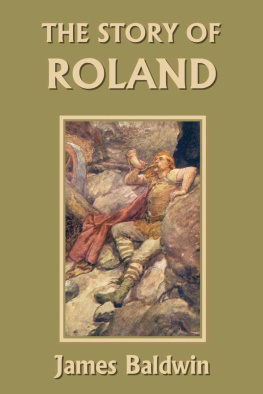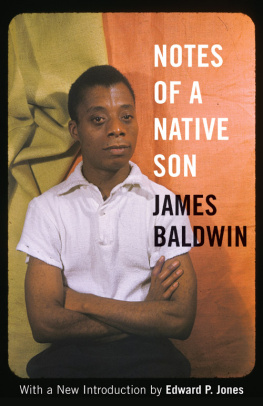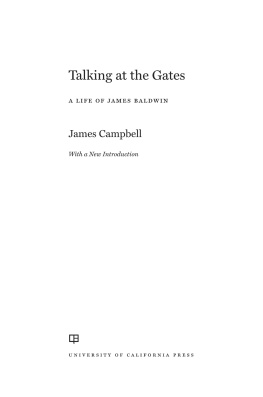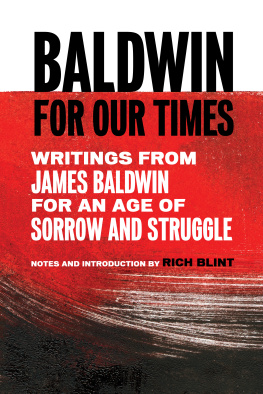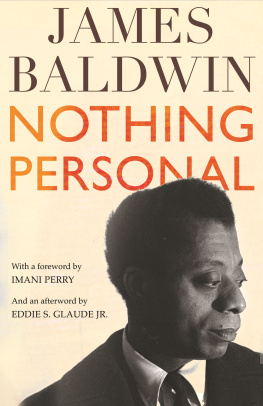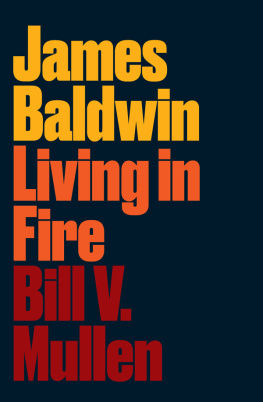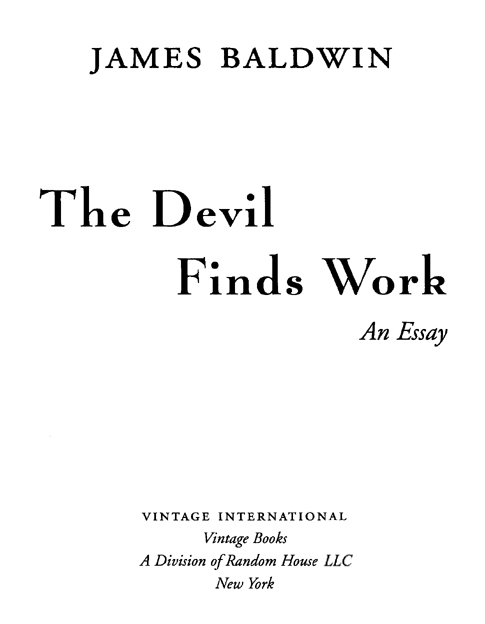His instructive comments reveal what a black child and black audiences in general perceive in white-produced movies, particularly those with biracial parts. Typical Baldwin eloquence tinged with religious fervor.
It is James Baldwin testifying honestly to his own experience at the movies. It is his experience and as such it either makes us see a point of view we are unlikely to have seen before (if we happen to be white) or confirms a way of looking at things for which we are unlikely to have gotten public affirmation (if we happen to be black).
Moralistic fervor, a high literary seriousness, the authority of the survivor, of the witnessthese qualities made Baldwin unique.
A provocative discussion.
FIRST VINTAGE INTERNATIONAL EDITION, SEPTEMBER 2011
Copyright 1976 by James Baldwin
All rights reserved. Published in the United States by Vintage Books, a division of Random House LLC, a Penguin Random House Company, New York, and in Canada by Random House of Canada Limited, Toronto. Originally published in hardcover in the United States by The Dial Press, New York, in 1976.
Vintage is a registered trademark and Vintage International and colophon are trademarks of Random House, Inc.
Grateful acknowledgment is made to the following for permission to reprint previously published material:
Alfred Music Publishing Co. Inc. and Hal Leonard Corporation: Lyrics from The Man That Got Away from the motion picture A Star Is Born, lyrics by Ira Gershwin, music by Harold Arlen, copyright 1954 (Renewed) by Harwin Music Co. and Ira Gershwin Music. All rights on behalf of Ira Gershwin Music administered by WB Music Corp. All rights reserved. Reprinted by permission of Alfred Music Publishing Co. Inc. and Hal Leonard Corporation. Countdown Media: Lyrics from Sing Sing Blues by Joseph Kuhn. Reprinted by permission of Countdown Media.
The Library of Congress has cataloged the Dial Press edition as follows:
Baldwin, James.
The devil finds work : an essay / by James Baldwin.
p. cm.
1. Baldwin, James, 19241987KnowledgePerforming arts.
2. Motion picture plays, AmericanHistory and criticism.
3. African Americans in motion pictures.
PS3552.A45 Z515
791.43/09/73
76000028
eISBN: 978-0-8041-4968-6
Cover design by Helen Yentus
Cover photograph Karl Bissinger
www.vintagebooks.com
v3.1
For
PAULA-MARIA, on her birthday,
and JOHN LATHAM
and brother, DAVID MOSES
Contents
For our God is a consuming fire.
HEBREWS 12:29
ONE

Congo Square
J OAN CRAWFORD S STRAIGHT , narrow, and lonely back. We are following her through the corridors of a moving train. She is looking for someone, or she is trying to escape from someone. She is eventually intercepted by, I think, Clark Gable.
I am fascinated by the movement on, and of, the screen, that movement which is something like the heaving and swelling of the sea (though I have not yet been to the sea): and which is also something like the light which moves on, and especially beneath, the water.
I am about seven. I am with my mother, or my aunt. The movie is Dance, Fools, Dance.
I dont remember the film. A child is far too self-centered to relate to any dilemma which does not, somehow, relate to himto his own evolving dilemma. The child escapes into what he would like his situation to be, and I certainly did not wish to be a fleeing fugitive on a moving train; and, also, with quite another part of my mind, I was aware that Joan Crawford was a white lady. Yet, I remember being sent to the store sometime later, and a colored woman, who, to me, looked exactly like Joan Crawford, was buying something. She was so incredibly beautifulshe seemed to be wearing the sunlight, rearranging it around her from time to time, with a movement of one hand, with a movement of her head, and with her smilethat, when she paid the man and started out of the store, I started out behind her. The storekeeper, who knew me, and others in the store who knew my mothers little boy (and who also knew my Miss Crawford!) laughed and called me back. Miss Crawford also laughed and looked down at me with so beautiful a smile that I was not even embarrassed. Which was rare for me.
Tom Mix, on his white horse. Actually, it was Tom Mixs hat, a shadow in the shadow of the hat, a kind of rocky background (which, again, was always moving) and the white horse. Tom Mix was a serial. Every Saturday, then, if memory serves, we left Tom Mix and some bleakly interchangeable girl in the most dreadful dangeror, rather, we left the hat and the shadow of the hat and the white horse: for the horse was not interchangeable and the serial could not have existed without it.
The Last of the Mohicans: Randolph Scott (a kind of fifteenth-rate Gary Cooper) and Binnie Barnes (a kind of funky Geraldine Fitzgerald), Heather Angel (a somewhat more bewildered Olivia de Havilland) and Philip Reed (a precursor of Anthony Quinn). Philip Reed was the Indian, Uncas, whose savage, not to say slavish adoration of Miss Angels fine blonde frame drives her over a cliff, headlong, to her death. She has chosen death before dishonor,
20,000 Years in Sing Sing: Spencer Tracy and Bette Davis. By this time, I had been taken in hand by a young white schoolteacher, a beautiful woman, very important to me. I was between ten and eleven. She had directed my first play and endured my first theatrical tantrums and had then decided to escort me into the world. She gave me books to read and talked to me about the books, and about the world: about Spain, for example, and Ethiopia, and Italy, and the German Third Reich; and took me to see plays and films, plays and films to which no one else would have dreamed of taking a ten-year-old boy. I loved her, of course, and absolutely, with a childs love; didnt understand half of what she said, but remembered it; and it stood me in good stead later. It is certainly partly because of her, who arrived in my terrifying life so soon, that I never really managed to hate white peoplethough, God knows, I have often wished to murder more than one or two. But Bill Millerher name was Orilla, we called her Billwas not white for me in the way, for example, that Joan Crawford was white, in the way that the landlords and the storekeepers and the cops and most of my teachers were white. She didnt baffle me that way and she never frightened me and she never lied to me. I never felt her pity, either, in spite of the fact that she sometimes brought us old clothes (because she worried about our winters) and cod-liver oil, especially for me, because I seemed destined, then, to be carried away by whooping cough.
I was a child, of course, and, therefore, unsophisticated. I dont seem ever to have had any innate need (or, indeed, any innate ability) to distrust people: and so I took Bill Miller as she was, or as she appeared to be to me. Yet, the difference between Miss Miller and other white people, white people as they lived in my imagination, and also as they were in life, had to have had a profound and bewildering effect on my mind. Bill Miller was not at all like the cops who had already beaten me up, she was not like the landlords who called me nigger, she was not like the storekeepers who laughed at me. I had found white people to be unutterably menacing, terrifying, mysteriouswicked: and they were mysterious, in fact, to the extent that they were wicked: the unfathomable question being, precisely, this one: what, under heaven, or beneath the sea, or in the catacombs of hell, could cause any people to act as white people acted? From Miss Miller, therefore, I began to suspect that white people did not act as they did because they were white, but for some other reason, and I began to try to locate and understand the reason. She, too, anyway, was treated like a nigger, especially by the cops, and she had no love for landlords.


